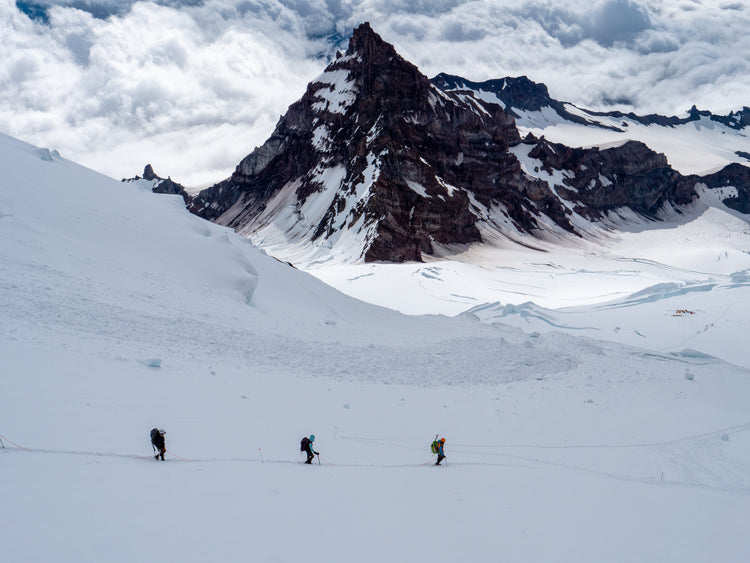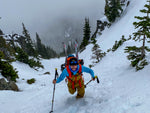If you looked at this blog title and thought “what the heck are they talking about, there’s only one type of mountaineering” we wouldn’t blame you, and until the last few decades, you would have pretty much been right. And while the core goals of mountaineering have remained the same over the years (see mountain, summit mountain, return home safely from mountain), the techniques, gear, and philosophies behind achieving those goals have branched into several distinct types of mountaineering.
As participants, observers, and outfitters of the last 50+ years of mountaineering, we think we’ve got a pretty good handle on how the sport has progressed - here’s our take on it.
Mountaineering vs Climbing
The terms “climbing” and “mountaineering” are often used interchangeably, or in tandem; you’re going mountaineering, which means you’re going to climb a mountain. One way to think about this issue with syntax is to look at mountaineering as the technical side of mountain climbing.
Increasingly, however, when you hear the term “climbing” it’s in reference to rock climbing specifically, as opposed to mountaineering. And while mountaineering can certainly incorporate elements or even stretches of true rock climbing, the sports are absolutely different. Mountaineering is significantly older, requires a broader skillset, and pits humans against weather and the elements far more often than rock climbing.
Ice climbing is another specific form of mountain climbing that, again, mountaineering often encompasses. It uses tools and techniques more in line with mountaineering than rock climbing (think crampons and ice tools) but we still consider it more of a sport within mountaineering than a type of mountaineering itself. If a route requires both ice and rock climbing, it’s considered to be “mixed.”
Types of Mountaineering
So now that we’ve got the “climbing” vs “mountaineering” debacle out of the way, let’s look at specific types of mountaineering. Each can include stretches of rock, ice, and mixed climbing, as well as glacial travel and high-altitude skills. The 2 main types of mountaineering, as we see them, are expedition and alpine.
Expedition Style
When you think of the “golden age” of mountaineering, what comes to mind? For us, it’s usually colonial elites with mile-long mule trains making their way into un-westernized mountain ranges in an attempt to “conquer” a peak. This was the birth of expedition mountaineering, a style that approached mountain climbing with the same military-like structure as many other exploratory ventures in the late 19th and early 20th centuries; in fact, the parallels between military operations and expedition mountaineering run so deep that it is often called “siege style” mountaineering instead.
While your average climber is no longer an Oxford-educated elite with the blessing of the crown, many of the same principles established in the golden age of mountaineering are still in play today. Some of these tried and true principles include establishing sequences of camps, hiring local porters to carry supplies, and setting aside months to methodically acclimatize, put routes in place, and eventually push for the summit. We still see this style used on many of the world's least accessible mountains, such as Everest, Denali, and K2.
Alpine Style
In anthropology, “schismogenisis” refers to a society adapting certain cultural values in direct opposition to values of their neighbors that they dislike. That is exactly how alpine-style mountaineering was born. In the 1970s, there was a philosophical pushback (aided by the counter-culture movement in the United States) against the “conquerer” motivations behind mountaineering. Alpinists found the siege-style tactics of expedition mountaineering to be inefficient and out of touch with nature, believing the best way to climb a mountain was fast, light, and self-supported.
Whereas expedition-style mountaineering relies on many human-centric advantages such as stocked camps, fixed routes, and local porters, alpinists prefer to swap those comforts for a fast and light approach, getting up and down the mountain as quickly as possible. While this exposes them to higher risk when weather rolls in, it also means they spend less time exposed to objective dangers such as rock and icefall.
So which is better?
It’s a loaded question, and one we don’t plan on answering here. Many consider alpine-style mountaineering to be a “purer” form of mountain climbing, pitting man against nature without the benefits of established camps and supply trains. Then again, others see alpinists as reckless climbers who pointlessly endanger themselves by not utilizing the many advantages we’ve developed as humans over the last few hundred years.
The way we see it, as long as you’re getting above treeline and experiencing the beauty, physical exertion, and endlessly addicting satisfaction of summiting, you’re a mountaineer.
Till next time,
Happy Climbing!


